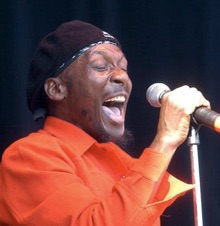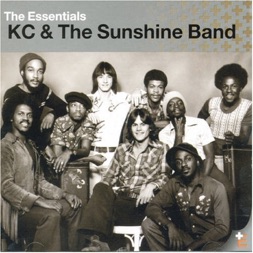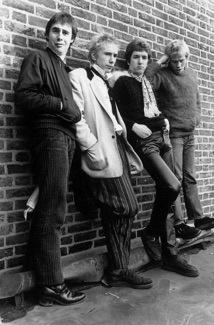UNIT 14
Background
-
1.Each of the styles discussed in this chapter came from outside the mainstream and, except for disco, were not commercially successful.
-
2.They shared a rhythmic bond; all have more active rhythms than rock. Yet all are rock styles that would shape American popular music for the rest of the century.
Funk
-
1.From as early as the 1950s, the term “funk” was used for a simpler and more blues-oriented jazz style. By the early 1970s funk described a particular style of black music that emphasized a complex rhythmic groove.
-
2.James Brown had provided the basics of funk, but Sly Stone (b. 1944) made the real musical transition from soul to funk.
-
3.Sly and the Family Stone--see photos at right
-
a.Roots in Brown’s soul music style:
-
1)Layers of riffs in drums and horns;
-
2)No harmonic movement;
-
3)Intermittent vocals, with long pauses in between phrases.
-
b.New features:
-
1)A more active 16-beat rhythm creates a faster-moving layer, so there are more opportunities to conflict with the beat;
-
2)Denser texture, with multiple layers;
-
3)Plenty of riffs;
-
4)A spontaneous feeling, as if it is growing out of a basic groove.
-
c.“Thank You (Falettinme Be Mice Elf Agin)” (1970)
-
1)The social and political message of the lyrics contrasts with the upbeat and exuberant music.
-
2)Group singing most of the time.
-
3)A single chord throughout the entire song.
-
*Listen to “Thank You,” and follow the Listening Cue in the text.
-
-
4.Strong political and social messages would become a trend in African-American music. Stone’s innovations influenced jazz/rock fusion, the film music of Curtis Mayfield, and especially the music of George Clinton.
-
5.George Clinton (b. 1940)--see photo at right
-
a.Clinton formed 2 important funk bands: Parliament and Funkadelic. By 1981, he had consolidated the two versions of the band under the name P-Funk All Stars.
-
b.Three important members of James Brown’s band joined Clinton’s group after 1975: Bootsy Collins (bass), Maceo Parker (sax), and Fred Wesley (trombone). Clinton’s band included as many as 12 members at one time.
-
c.Clinton’s many aliases and flamboyant costumes are humorous, and his rhythms are upbeat. Yet the dark images of the lyrics contradict the happy groove.
-
d.“Tear the Roof off the Sucker” (1976)
-
1)Similar instrumentation to that of Sly Stone and James Brown, but more instruments create a denser texture. There are numerous layers:
-
a)Riffs and sustained chords in horns and keyboards;
-
b)High melodic lines from a synthesizer;
-
c)An active, syncopated bass line (Collins);
-
d)Backup singers and Clinton’s proto-rap style.
-
2)Only one chord throughout the song.
-
3)Clinton’s vocals, as well as the instrumental parts move at a 16-beat rhythm, over an 8-beat pattern laid down by the drums.
-
4)Overall darker sound due to Clinton’s voice and the prominence of the bass.
-
*Listen to “Tear the Roof off the Sucker,” and follow the Listening Cue in the text.
Reggae
-
1.Reggae is a Jamaican musical style that emerged in the 1970s and is connected with attempts at political and social reform there. Reggae is also connected to the religion Rastafarianism.
-
2.Musical influences of reggae
-
a.Rhythm and blues was a major influence in Jamaica, where the style was played on radio stations during the 1940s and 1950s. Musicians gradually absorbed R&B features into their style, and by the 1960s “ska” music appeared.
-
b.Ska has the shuffle rhythm of R & B, but in reverse. In shuffle, the long-short pattern accents the note that falls on the beat, the long. In ska the pattern is reversed to become short-long, so that the afterbeat is accented.
-
c.In the 2nd half of the 1960s, ska evolved into “rock steady,” which added a backbeat layer. This created a core rhythm at two speeds, slow and fast, with the beat-keeping in the middle of the texture, rather than in the bass. So, bass players were free to create additional patterns.
-
d.Rock steady evolved into reggae, when other rhythmic layers were added.
-
3.Jimmy Cliff (b. 1948)
-
a.Reggae singer and songwriter, who starred in and wrote the music for the film The Harder They Come in 1972, which deals with social injustice and police brutality.
-
b.While the lyrics of the movie’s songs are dark, the music is upbeat and rhythmic, perhaps enticing listeners to care about important issues by listening to happy music.
-
c.“The Harder They Come” (1972)
-
1)Title song from the film, which illustrates the seeming contradiction between lyrics and musical style.
-
2)Vocal style uses falsetto and melismas.
-
3)Large rhythm section creates a rich, complex texture, with the pulse embedded into the middle of the texture, rather than in the bass:
-
a)One keyboard (organ) has the backbeat and the other the afterbeat. This creates the reggae rhythm (ka-CHUN-ka);
-
b)Guitar and drums have the rock rhythm;
-
c)Bass has a free, bouncy line.
-
4)Dense texture, with lots of instrumental activity behind the vocals.
-
5)Verse/bridge/chorus form, as in Motown songs.
-
*Listen to “The Harder They Come,” and follow the Listening Cue in the text.
-
4.Bob Marley (1945-1981)--see photo at right
-
a.Reggae artist, whose international success and popularity allowed him to effect real change in Jamaican society.
-
b.Many of Marley’s songs are political, but others are more intimate like “Is This Love” (1978):
-
1)Slow, flowing vocal line, with a repeated riff in the verse.
-
2)Several percussion instruments, including Rastafarian drums.
-
3)Light beat-keeping in drums and tambourine, and a fast shuffle afterbeat in the organ move the song along.
-
*Listen to “Is This Love,” and follow the Listening Cue in the text.
-
5.Reggae as international music
-
a.Outside Jamaica, reggae first became popular in Great Britain, due to the large number of Jamaicans living there. During the 1970s, many British musicians wove the rhythms of ska and reggae into their songs.
-
b.In the later 1970s, reggae became known in the US and especially influenced African-American styles:
-
1.Because reggae puts the pulse in the mid range of the rhythmic texture, the bass became liberated from its beat-keeping role.
-
2.The practice of “toasting,” in which instrumental tracks were used as backdrops for the patter of DJs (see the photo of DJ Kool Herc at right) at Jamaican street parties, was a direct forerunner of rap.
Disco
-
1.The roots of the club scene
-
a.“Discothèque” is a French word that was used during World War II for a nightclub where dancing was featured. Discothèques opened in the US ca. 1960, and many of them catered to an exclusive clientele.
-
b.By the end of the 1960s, clubs had become more egalitarian and welcomed a wide variety of people--many of whom were part of a marginalized group seeking an outlet for expression through dance: blacks, Latinos, gays, and women.
-
c.Musical acts included Sly and the Family Stone, Stevie Wonder, Marvin Gaye, and the Philadelphia artists.
-
d.By the mid 1970s, disco went mainstream due to bands like KC and the Sunshine Band and to the movie Saturday Night Fever (1975).
-
e.At the same time strides were being made in Europe (especially in Germany) in creating and mixing instrumental tracks, which contained a variety of acoustic and synthesized sounds. These innovative tracks would become the background for singers.
-
2.Donna Summer (b. 1948)--see photo at right
-
a.While working in Europe, Summer met Giorgio Moroder, an innovative producer and technology expert, who would collaborate with her on many hits.
-
b.“I Feel Love” (1977)
-
1)Rich texture with no conventional instruments; everything is electronic.
-
2)Transforms the complex, syncopated 16-beat rhythms of funk and black pop into a danceable beat by making the 16-beat layer more obvious. There are 3 layers: beat (4), 2 times beat (8), and 4 times beat (16).
-
3)Busy repetitive rhythms intended for dancing contrast with Summer’s floaty voice.
-
*Click here for Summer singing “I Feel Love,” and follow the Listening Cue in the text.
-
3.The Village People--see photo at right
-
a.Formed by French producer, Jacques Morali, who recruited the 6 men off the streets and from gay clubs of New York. Dressing as macho stereotypes, the Village People were an inside joke; they mocked hyper-maleness while also appealing to a mainstream audience.
-
b.The Village People exemplifies the importance of the producer in disco music; the singers are incidental to the synthesized accompaniment.
-
c.“Y. M. C. A.” (1978)
-
1)The lyrics have fun with the YMCA being a place to “hang out with all the boys.”
-
2)The music has active, relentless, danceable rhythm (16-beat); an oversized rhythm section; lush orchestration, including strings and electronic instruments; catchy chorus melody; and repetitive harmonies.
-
*Listen to “Y. M. C. A,” and follow the Listening Cue in the text.
-
4.Culture, reception, and influence
-
a.Disco encouraged a hedonistic lifestyle and spread from cities to the suburbs during the late 1970s. It eventually provoked reactions (some of which were homophobic), not only to the lifestyle, but also to the mindless songs.
-
b.Like most dance fads that emerged with a new beat, disco was short-lived. Like the “jitterbug” of the 1930s, which had simpler musical features than the swing jazz that had inspired it, disco music was more accessible and less sophisticated than the funk and black pop that had preceded it.
-
c.While disco as dance music faded away, the new beat took root in the 1980s. Moreover, the emphasis on electronic sounds and club culture would continued into the next several decades.
Punk
-
1.Background and roots
-
a.Punk originated in the mid-1970s in small New York clubs with musicians who sought to recapture the revolutionary spirit of early rock.
-
b.They rebelled against the growing commercialism of mainstream rock and also against societal norms.
-
c.Groups like the Velvet Underground, the Ramones, and the Talking Heads promoted a revolutionary attitude that was reinforced by their abrasive sound.
-
d.The spirit was soon felt in Great Britain, where disaffected young people were looking for a way to express their frustration. The Sex Pistols, the Clash, and the Buzzcocks were important new wave groups in the UK.
-
2.Types of punk: extreme (punk) and more moderate (new wave)
-
a.Punk is a term used for the more extreme groups that encouraged violence against the system and used loud abrasive music, usually without keyboards. The most important are the Sex Pistols and the Ramones (see photos below).
-
b.Some punk artists like Patti Smith in New York and Elvis Costello in the UK sought to recapture the time when poetry was important in rock. (See photos above and at right.)
-
3.Features of punk
-
a.Powerful, loud, noisy music at fast tempos.
-
b.Guitar and bass distortion.
-
c.Purer version of the 8-beat rock rhythm, which is isolated and sped up; a note, a chord, or a drum stroke is often repeated at rock-beat speed:
-
1)The entire group reinforced the beat;
-
2)Rigid timekeeping is preferred over syncopation and rhythmic interplay;
-
3)So, punk moves towards simpler rather than more complicated rhythmic play.
-
4.The Sex Pistols--see photo at right
-
a.Founded by Malcolm McClaren, who operated a clothing boutique in London called SEX. The group did not have many musical skills, but as marketed and exploited by McClaren they gained the ability to provoke and outrage.
-
b.“God Save the Queen” (1977)
-
1)Lyrics criticize British royalty;
-
2)Aggressive, abrasive vocals;
-
3)Pure rock rhythm at a moderately fast tempo;
-
4)Thick, dense texture with distorted power chords;
-
5)Every element of the song underscores its inflammatory message.
-
*Watch the video of “God Save the Queen,” and follow the Listening Cue in the text.
-
-
c.Although the Sex Pistols broke up in 1978, they were extremely influential in their ability to provoke outrage, not only against ruling classes but also, against the “peace and love” generation of the 1960s.
Punk Reverberations: New Wave
-
1.“New wave” is actually an umbrella term for music that was anti-establishment in the mid-1970s. It embraced not only punk, but also other bands that reacted against prevailing tastes.
-
2.Because new wave music aims at clear presentation of the lyrics, there is usually modest instrumentation: guitar, bass, drums, keyboard. The texture is less dense than in punk. Both styles share the simpler approach to rhythm.
-
3.New wave songs project the same rebellious attitudes as punk, but they do it with more finesse and with more attention to the lyrics.
-
4.The Talking Heads--see photo at right
-
a.American new wave group with David Byrne (b. 1952) as lead singer.
-
b.The group’s art school training and their exploration into various musical styles, especially non-western music, inform their songs.
-
c.“Psycho Killer” (1977)
-
a)Dark lyrics describe someone in the process of going mad.
-
b)Byrne’s sings with no emotion, as if he is ready to explode.
-
c)Various styles are used to accompany the vocals (unlike in punk): edgy beginning with chords in the interlude where Byrne switches to French.
-
d)Spare texture.
-
e)Simple, understated rock beat with little syncopation.
-
*Watch the video of “Psycho Killer,” and follow the Listening Cue in the text.
-
-
d.The Talking Heads had a 16-year career and created one of the most innovative sound worlds of the 1970s. David Byrne would become a leading figure in the world music movement of the 1980s (See Unit 20).
-
5.The Clash--see photo at right
-
a.British new wave group, which began as a pure punk band. While their songs continued to rail against political and social injustice, their musical style eventually became more versatile.
-
b.“Death or Glory” (1979)
-
1)Lyrics are in the forefront: using brutal images, they comment on one of the group’s central issues: whether money will motivate someone to sell out.
-
2)Rock and roll features: verse/chorus form (with catchy hooks in the chorus); simple, active rock rhythm.
-
3)Thick textures with distorted chords.
-
*Watch the video of “Death or Glory,” and follow the Listening Cue in the text.
-
-
c.The Clash demonstrated how to use the power of punk with a message that matters.
-
6.The Influence of punk and new wave
-
a.Punk and new wave music restored the sense of daring in rock, and even took it up a level. The message of rebellion is primary, which accounts for the relative simplicity of the musical materials.
-
b.The new conception of the rock rhythm would influence later, especially alternative, styles.
-
c.Served as a link between the significant rock of the 1960s (Bob Dylan and the Beatles) and the significant rock of the 1980s (Bruce Springsteen and U2).
Looking Back, Looking Ahead
-
1.Funk, reggae, disco, and punk influenced the music of the 1980s and beyond. New electronic sounds and effects, influences from outside the US, the new approach to rhythm, and the recapturing of early rock’s rebellious attitude made this era important.
-
2.By the 1980s rock would be significantly different from its 1960s beginnings. New attitudes, sounds, and rhythms would remake rock, and those styles that remained closest to its spirit would be labeled “alternative.”
Photos
-
1.Sly and the Family Stone
-
2.The Talking Heads
-
3.George Clinton and Parliament
-
4.The Sex Pistols
-
5.Bob Marley poster

New Trends of the Late 1970s


Unit Fourteen
New Trends of the Late 1970s




Sly Stone

George Clinton



Jimmy Cliff


Bob Marley
DJ Kool Herc, who had emigrated from Jamaica to the Bronx, brought toasting with him.
George Clinton and Parliament

Rastafarian drums


Donna Summer, “Queen of Disco”


The Village People


Chic, one of the most successful disco groups
Patti Smith

Elvis Costello

The Sex Pistols

The Talking Heads

The Clash



Bono of U2
